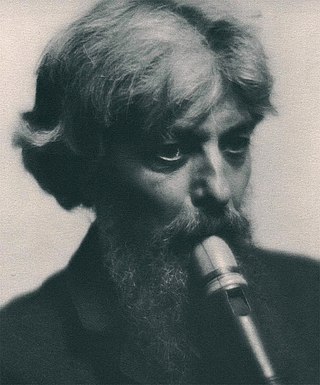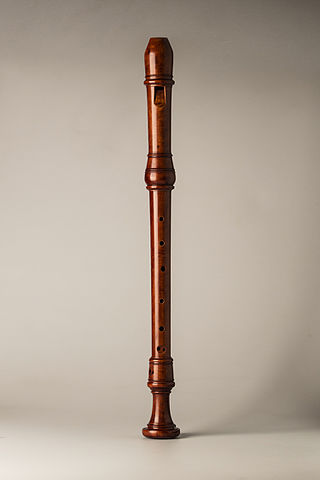Frederick G. Morgan (8 April 1940 - 16 April 1999) was an Australian recorder maker.
Frederick G. Morgan (8 April 1940 - 16 April 1999) was an Australian recorder maker.
Morgan first played recorder at age 12 in the family's home in Mentone, Victoria, Australia. After studying commercial art at Melbourne Technical College in 1959, he went to work at the Pan Recorder factory where he became enamored with the recorder. [1]
The Frederick Morgan Recorder Consort performed between 1964 and 1969, often accompanied on keyboard by his first wife, Jan. He appeared in the Melbourne Bach Festival, with the Tudor Choristers and the Melbourne Chorale. With Carl Dolmetsch and the Paul McDermott String Quartet, he performed Bach's Fourth Brandenburg Concerto in 1966 at Wilson Hall, Melbourne University. He continued to perform into 1970s with his second wife Ann Murphy, a harpsichordist.
He won a Churchill Fellowship to study Recorder Manufacture and Usage in Europe in 1970. There he studied instruments in museums and private collections and met the recorder virtuoso Frans Brüggen, [2] who purchased a Morgan recorder in 1973. When Frans toured Australia with his Orchestra of the Eighteenth Century in 1985, they performed on original instruments from the 17th and 18th centuries, except for Frans who performed on his Morgan recorder.
Morgan set up a workshop in Amsterdam in 1978, but returned to Daylesford, Victoria in 1980. His instruments became much sought after and treasured by performers around the world. [3] He is particularly noted for his role in developing the Ganassi recorder, and documenting the 17th century recorders found in the Rosenborg Castle in Denmark.
Morgan died in a car accident in 1999, but his workshop continues to produce partially finished bodies to be finished by other recorder makers, including Nikolaj Ronimus and Jacqueline Sorel. Mollenhauer has licensed the name to be used with their Morgan Denner series of altos. [4]

The recorder is a family of woodwind musical instruments in the group known as internal duct flutes: flutes with a whistle mouthpiece, also known as fipple flutes, although this is an archaic term. A recorder can be distinguished from other duct flutes by the presence of a thumb-hole for the upper hand and seven finger-holes: three for the upper hand and four for the lower. It is the most prominent duct flute in the western classical tradition.

Carl Philipp Emanuel Bach, also formerly spelled Karl Philipp Emmanuel Bach, and commonly abbreviated C. P. E. Bach, was a German Baroque and Classical period composer and musician, the fifth child and second surviving son of Johann Sebastian Bach and Maria Barbara Bach.

Trevor David Pinnock is a British harpsichordist and conductor.

Eugène Arnold Dolmetsch, was a French-born musician and instrument maker who spent much of his working life in England and established an instrument-making workshop in Haslemere, Surrey. He was a leading figure in the 20th-century revival of interest in early music.
Frederick, Frederic or Fred Morgan may refer to:

Jacob Denner was a woodwind instrument maker of Nuremberg.
Carey Beebe is an Australian harpsichord maker and technician.

Peter Watchorn is an Australian-born harpsichordist who has combined a virtuosic keyboard technique, musical scholarship and practical experience in the construction of harpsichords copied from original instruments of the 17th and 18th centuries. As well as presenting many solo public performances and broadcasts of baroque keyboard music and participating in choral and orchestral performances, he has made numerous commercial CD recordings of solo harpsichord music from the 17th and 18th centuries.
Dan Laurin is a Swedish recorder player.

The Sonata in E major for flute and basso continuo is a sonata for transverse flute and figured bass composed by J. S. Bach in the 1740s. It was written as the result of a visit in 1741 to the court of Frederick the Great in Potsdam, where Bach's son Carl Philipp Emanuel had been appointed principal harpsichordist to the king the previous year. It was dedicated to Michael Gabriel Fredersdorf, the king's valet and private secretary, who, like the king, was an amateur flautist.
RMIT Link is a division of the Royal Melbourne Institute of Technology (RMIT) around student life and historically was an unincorporated entity, the campus union of the RMIT in Melbourne, Victoria, Australia. It was formed in 1968 and currently consists of the following branches: Arts and Culture, Sport, City Fitness, "Recreation", "Orientation and Transition" and Administration.
Bruce Haynes was an American and Canadian oboist, recorder player, musicologist and specialist in historical performance practice.
Musical instruments used in Baroque music were partly used already before, partly are still in use today, but with no technology. The movement to perform music in a historically informed way, trying to recreate the sound of the period, led to the use of historic instruments of the period and to the reconstruction of instruments.
The garklein recorder in C, also known as the sopranissimo recorder or piccolo recorder, is the smallest size of the recorder family. Its range is C6–A7 (C8). The name garklein is German for "quite small", and is also sometimes used to describe the sopranino in G. Although some modern German makers use the single-word form Garkleinflötlein, this is without historical precedent. Double holes for the two lowest notes (used on the larger recorders to achieve a fully chromatic scale) are uncommon. The instrument is usually notated in the treble clef two octaves lower than its actual sound. The garklein recorder is only about 16 to 18 cm long and is different from larger recorders in that it is usually made in one piece due to its size.

The voice flute (also the Italian flauto di voce and the French flûte de voix are found in English-language sources) is a recorder with the lowest note of D4, and is therefore intermediate in size between the alto and tenor recorders.
Genevieve Lacey is an Australian musician and recorder virtuoso, working as a performer, creator, curator and cultural leader. The practice of listening is central to her works, which are created collaboratively with artists from around the world. Lacey plays handmade recorders made by Joanne Saunders and Fred Morgan. In her collection, she also has instruments by David Coomber, Monika Musch, Michael Grinter, Paul Whinray and Herbert Paetzold.
Adriana Breukink was a Dutch recorder maker and player from Enschede, Netherlands, who made Renaissance, baroque and modern instruments.
Kunath is a recorder maker in Fulda, Germany.
Peter Bressan was a noted woodwind instrument maker of whose work several examples exist in museums and private collections.

Peter Harlan was a German multi-instrumentalist and musical instrument maker. In the 1920s he was an employee of the Munich magazine Der Gitarrenfreund.